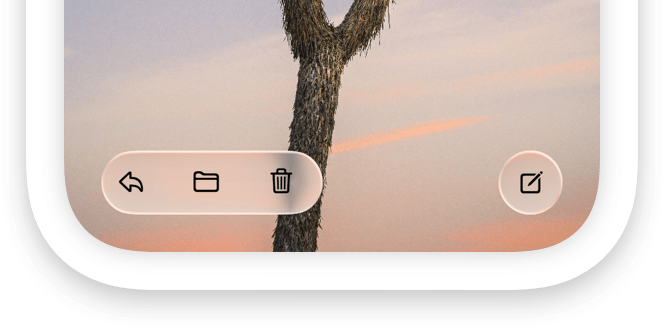What is Liquid Glass?
Liquid Glass is a revolutionary software design language and user interface "material" ceremoniously unveiled by Apple at WWDC 2025. It marks the most extensive and profound visual and interactive overhaul of its software ecosystem since the release of iOS 7 in 2013.
Its core concept is to introduce a "glass" with physical properties into the digital interface. This "material" is semi-transparent and can reflect and refract its surroundings and the content beneath in real-time, creating an unprecedented sense of depth and space. This effect applies not only to small controls like buttons, switches, and sliders, but also to larger areas such as tab bars, sidebars, and notifications.


Illustration: The transparency and dynamic nature of Liquid Glass
Liquid Glass is not merely a static visual effect. It is highly dynamic and responsive: it can "ripple" or "flow" in response to user touch and device movement, presenting delicate specular highlights. UI elements, like the new dynamic tab bar in iOS 26, can expand, contract, and even "morph" based on scrolling, giving the interface an unprecedented liveliness.
Furthermore, the color of Liquid Glass is intelligently influenced by surrounding content and can adaptively adjust between standard light/dark modes and new appearances like "new colorful light/dark" and "new simple" looks. Its design is deeply inspired by visionOS, aiming to build a unified, more expressive, and immersive user experience for all major Apple OSs, including iOS 26, iPadOS 26, and macOS Tahoe 26.
Core Design Philosophy
The essence of Liquid Glass lies in its unique "material" properties, which redefine user interaction with digital interfaces, pursuing expressiveness, focus, intuitiveness, and harmony.
Translucency & Refraction
The material reflects and refracts its surroundings and content in real-time, creating a deep, glass-like sense of space and light interaction.
Dynamic Response & Morphing
It responds sensitively to user interaction, allowing UI elements to expand, contract, or even "morph," like the collapsible tab bar in iOS.
Color Adaptation
Its color is influenced by content and supports new appearances like colorful light/dark tones, perfectly integrating into the environment.
Inspired by visionOS
Deeply inspired by the sense of depth and dimension in visionOS, it gradually integrates spatial computing design concepts into 2D operating systems.
A Unified Ecosystem Experience
Liquid Glass spans all major Apple platforms, establishing an unprecedented sense of harmony while preserving the unique charm of each platform. Click the device buttons below to explore its specific applications on different platforms.
Developer Guide
Apple provides a rich set of APIs, design guidelines, and tools to help developers embrace and implement Liquid Glass in their applications, ensuring a consistent and high-quality experience.
Key Support in SwiftUI
As a modern UI framework, SwiftUI offers the most robust support for Liquid Glass. Developers can use new APIs to easily add glass effects to custom views and achieve smooth morphing transitions.
- 1
.glassEffect()modifier: Adds a configurable Liquid Glass effect to a view. - 2
GlassEffectContainer: Optimizes rendering performance for multiple views and supports shape blending. - 3
matchedGeometryEffect: Achieves smooth cross-view morphing animations.

Illustration: Implementing Liquid Glass effects in SwiftUI
HIG Core Principles
The updated Apple Human Interface Guidelines (HIG) include detailed specifications for Liquid Glass, guiding developers to create experiences that are both beautiful and user-friendly.
- Content First: Keep the most important content in the visual focus.
- Use Color Sparingly: Use color moderately to ensure readability and let content colors stand out.
- Test for Accessibility: Always test your interface with system accessibility settings.
- Avoid Overuse: Apply effects to custom controls with restraint.
- Leverage System Frameworks: Use standard components whenever possible to automatically adapt to the new style.
Cross-Framework & New Capability APIs
Apple has introduced updated APIs for SwiftUI, UIKit, and AppKit to support the new design. Additionally, new APIs for computationally intensive tasks and audio processing have been released to further unlock device potential.
- Automatic Adaptation: Standard components like toolbars and forms automatically get the new look.
- Background Tasks API: iPadOS 26 provides a new API allowing intensive tasks to run in the background, with progress displayed as a Live Activity.
- Enhanced Audio APIs: iPadOS 26 supports per-app/site microphone selection and enables studio-quality recording with AirPods.
- Performance Considerations: The framework has been optimized for rendering performance to maintain a smooth user experience.
In-Depth Analysis
Explore the deeper topics behind Liquid Glass, including accessibility, design comparisons, and clarification of related technologies.
The semi-transparent and dynamic nature of Liquid Glass has raised community concerns about accessibility, especially regarding contrast and clarity. Apple addresses this through the system-level "Reduce Transparency" feature and detailed HIG guidelines. Developers are responsible for ensuring their apps, especially custom components, provide a clear and usable fallback experience when accessibility settings are enabled.
Liquid Glass and Google Material You represent different design philosophies. Liquid Glass focuses on simulating the physical properties and spatial sense of materials, emphasizing translucency and depth. In contrast, Material You focuses more on dynamic color theming based on the user's wallpaper, offering a more overt "personalization" experience. Both are leveraging AI for smart features, but their visual frameworks and emotional tones are distinctly different.
Liquid Glass clearly brings the core concepts designed for spatial computing in visionOS (like materials, lighting, and depth) to traditional 2D screens. This not only unifies the design language across all Apple platforms but also provides a more coherent user experience when switching devices, serving as a crucial stepping stone for future, more immersive interactive experiences.
It is essential to distinguish between these two similarly named but completely different technologies:
Liquid Glass (UI)
A new software design language and user interface aesthetic concerned with on-screen visual presentation and interaction.
Liquidmetal (Hardware)
A hardware material technology involving amorphous metal alloys with high strength and corrosion resistance, used for manufacturing physical device components.